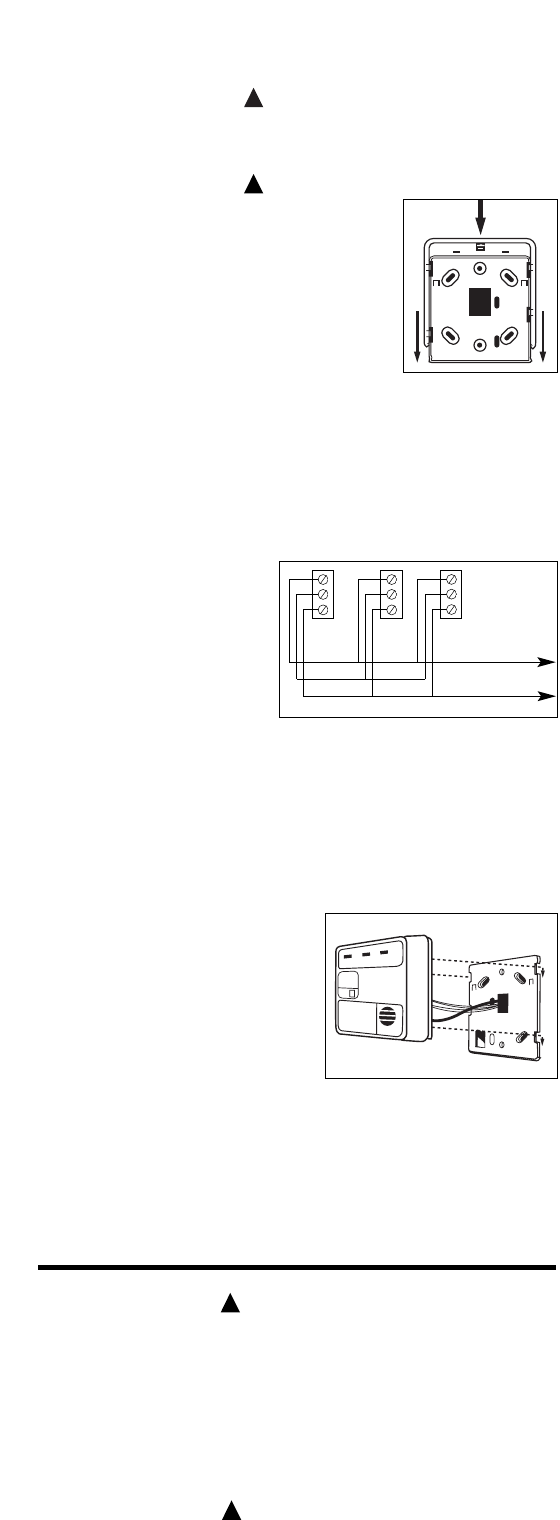
4
How to Install Your CO Alarm
Once you have decided the best place to install the CO alarm(s), follow
these steps:
ELECTRICAL SHOCK HAZARD. Turn off power at the main fuse box or
circuit breaker by removing the fuse or switching the circuit breaker to the
OFF position.
Check local codes for specific mounting require-
ments in your area.
1. From back of CO alarm, slide mounting plate
and lift from base. See Figure 4.
2. Connect new 9-volt battery to battery connector
inside compartment and slide door closed
snapping it into place. New 9V battery comes
from the factory installed backwards inside the
battery compartment. Replace battery with
Eveready 216, 522, 1222 or equivalent from your
local retailer.
3. Align mounting plate with junction box mounting holes.
4. Gently pull household wires through center hole of mounting plate.
5. Secure mounting plate to junction box.
6. With a small wire connector, connect white wire from the CO alarm to
white household wire.
7. Connect black wire from the
CO alarm to the black house-
hold wire.
8. For interconnecting alarms:
• Use #18 AWG minimum
solid or stranded wire. When
interconnecting, maximum
wire length between any two
is 1,500 feet for #18 AWG or
4,000 feet for #14 AWG
(20 OHMS loop resistance.) See Figure 5.
• This CO alarm may be interconnected with as many as 11 other Firex
CO alarms or with as many as 12 Firex smoke alarms, and 5 CO or
heat alarms for a total number of 18 units.
• This CO alarm may be interconnected with Firex models FADC, ADC,
PAD and ADH smoke and heat alarms. DO NOT connect to any other
model CO, smoke or heat alarm.
• Note that this CO alarm will not
cause interconnected smoke and
heat alarms to sound their horn. This
CO alarm will remain silent if inter-
connected smoke and heat alarms
are sounding even if there is a build-
up of CO.
• Connect CO and smoke alarms to a
single AC branch circuit. If local
codes do not permit connection to a
single AC branch circuit, be sure the
neutral wire is common to all circuits used.
9. Align tabs on back of base with slots on side of mounting plate. Slide
base down to lock into position. See Figure 6.
10. Turn power on at the main fuse box or circuit breaker. The CO alarm will
flash the red LED and emit a short beep during its power-up cycle. The
green POWER light will stay on as long as the CO alarm is receiving AC
power.
WARNING
!
CAUTION
!
FIGURE 4
FIGURE 5
WHITE
YELLOW
BLACK
YELLOW
WHITE
BLACK
WHITE
BLACK
TO 120 VAC (HOT)
TO NEUTRAL
FIGURE 6
ADVERTENCIA
CONOZCA LAS FUENTES COMUNES DE MONÓXIDO DE CARBONO.
Las fuentes comunes de monóxido de carbono son calderas para
calefacción, aparatos para calentar, calentadores de agua, cocinas o
estufas a gas, calentadores a queroseno, chimeneas, parrillas que se
usan dentro de la casa, motores o máquinas que estén funcionado en
garajes unidos a la casa y dispositivos a gasolina como los generadores
y las bombas que se usan en emergencias. Conozca cómo usar
adecuadamente cada aparato o dispositivo y haga que les den servicio
y se limpien regularmente. Use el sentido común y siga cuidadosa-
mente las instrucciones sobre seguridad y riesgos siempre que los use.
ADVERTENCIA
Las personas con problemas médicos pueden considerar usar dispositivos
de advertencia que tengan señales audibles o visuales para concentraciones
de monóxido de carbono por debajo de 30 ppm.
Características de la alarma de CO
• Pila de repuesto de 9 V
• Arnés para conexión rápida de los alambres para facilitar y abreviar la
instalación
• Interconexión inteligente: cable compartido de interconexión con el cual las
alarmas de humo distinguen entre las señales de alarma de hum y de
monóxido de carbono en el cable de interconexión
• Su forma cuadrada la diferencia claramente de las alarmas de humo
• Botón grande para probar y recalibrar: fácil de usar
• Sistema de alarma de luz y sonido de tres niveles; usted siempre sabe si:
1. La unidad está recibiendo la corriente alterna.
2. La alarma requiere cambiarse de inmediato.
3. Hay niveles peligrosos de CO.
• Especificaciones eléctricas: 120 V de CA, 60 Hz, 0,05 amp.
!
!
Español


















